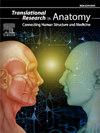Case analysis and clinical implications of a hemangioma located between the pronator quadratus and interosseous membrane
Q3 Medicine
引用次数: 0
Abstract
Background
Hemangiomas are seldom considered as a differential diagnosis for conditions with common etiologies. Reports detailing hemangiomas in unique locations with comprehensive analyses are scarce. This study aims to investigate a hemangioma uniquely located between the pronator quadratus (PQ) and the interosseous membrane (IOM) with gross, histological, and biomechanical analyses.
Methods
A unilateral (right) hemangioma was discovered during routine dissection of an adult human cadaver, measured, weighed, transected, and photographed. Two tissue samples were collected, processed for histology (H&E), and scanned for examination via digital light microscopy. Maximal isometric force (Fmax) of the overlying PQ was calculated to determine the central force vector that would compress the hemangioma upon contraction.
Results
The 4.85 g multilobulated hemangioma was supplied by the anterior interosseous artery and bound by the PQ, IOM, and distal radius and ulna. The hemangioma was roughly circular (r = ∼2.65 cm) in the coronal plane and disproportionally thicker on its ulnar side (1.88 cm vs. 0.45 cm). Histological analysis revealed atrophic skeletal muscle and clusters of leukocytes. The PQ muscle exhibited a Fmax of 45.47 N and the ability to compress the hemangioma with 12.56 N.
Conclusions
Despite its likelihood for provoking sequelae, a hemangioma presenting between the PQ and IOM may not be considered when evaluating musculoskeletal pain, distal forearm fractures, compartment syndrome, or carpal tunnel syndrome. This study may provide new and important insights to orthopedists, vascular surgeons, medical educators, clinical anatomists, and allied health professionals when analyzing, diagnosing, or treating related cases.
旋前方肌与骨间膜间血管瘤的病例分析及临床意义
背景:血管瘤很少被认为是具有共同病因的疾病的鉴别诊断。详细介绍独特位置血管瘤的综合分析报告很少。本研究旨在通过大体、组织学和生物力学分析来研究位于旋前方肌(PQ)和骨间膜(IOM)之间的血管瘤。方法对一具成人尸体进行常规解剖,发现单侧(右侧)血管瘤,测量、称量、横切、拍照。收集两个组织样本,进行组织学处理(H&;E),并通过数字光学显微镜扫描检查。计算上覆PQ的最大等距力(Fmax),以确定在收缩时压缩血管瘤的中心力矢量。结果4.85 g多叶状血管瘤由骨间前动脉供血,并由PQ、IOM和远端桡骨、尺骨结合。血管瘤在冠状面大致呈圆形(r = ~ 2.65 cm),在尺侧不成比例地增厚(1.88 cm vs. 0.45 cm)。组织学分析显示骨骼肌萎缩和白细胞聚集。PQ肌的Fmax为45.47 N,压缩血管瘤的能力为12.56 N。结论:尽管有可能引发后遗症,但在评估肌肉骨骼疼痛、前臂远端骨折、筋膜室综合征或腕管综合征时,PQ和IOM之间出现的血管瘤可能不被考虑。本研究可能为骨科医生、血管外科医生、医学教育者、临床解剖学家和相关卫生专业人员在分析、诊断或治疗相关病例时提供新的重要见解。
本文章由计算机程序翻译,如有差异,请以英文原文为准。
求助全文
约1分钟内获得全文
求助全文
来源期刊

Translational Research in Anatomy
Medicine-Anatomy
CiteScore
2.90
自引率
0.00%
发文量
71
审稿时长
25 days
期刊介绍:
Translational Research in Anatomy is an international peer-reviewed and open access journal that publishes high-quality original papers. Focusing on translational research, the journal aims to disseminate the knowledge that is gained in the basic science of anatomy and to apply it to the diagnosis and treatment of human pathology in order to improve individual patient well-being. Topics published in Translational Research in Anatomy include anatomy in all of its aspects, especially those that have application to other scientific disciplines including the health sciences: • gross anatomy • neuroanatomy • histology • immunohistochemistry • comparative anatomy • embryology • molecular biology • microscopic anatomy • forensics • imaging/radiology • medical education Priority will be given to studies that clearly articulate their relevance to the broader aspects of anatomy and how they can impact patient care.Strengthening the ties between morphological research and medicine will foster collaboration between anatomists and physicians. Therefore, Translational Research in Anatomy will serve as a platform for communication and understanding between the disciplines of anatomy and medicine and will aid in the dissemination of anatomical research. The journal accepts the following article types: 1. Review articles 2. Original research papers 3. New state-of-the-art methods of research in the field of anatomy including imaging, dissection methods, medical devices and quantitation 4. Education papers (teaching technologies/methods in medical education in anatomy) 5. Commentaries 6. Letters to the Editor 7. Selected conference papers 8. Case Reports
 求助内容:
求助内容: 应助结果提醒方式:
应助结果提醒方式:


